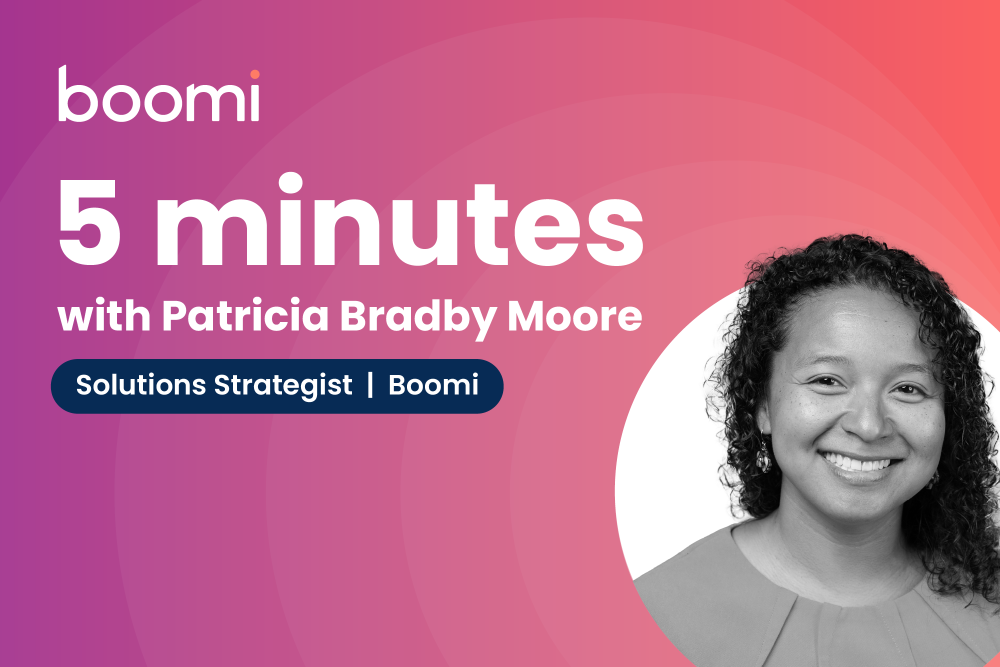Boomi highlights business thought leaders, the market trends they see, and the work their organizations are doing. And their hot takes on food integrations, too.
When Boomi Solutions Strategist Patricia Bradby Moore joined Boomi she wasn’t a “techie.” She had a wide range of experience in other fields, from entertainment, to non-profit, to academia — but hadn’t previously worked for a technology company. But she had a ton of entrepreneurial experience and a varied skill set that was ideal for a company that’s all about “connecting everyone to everything, anywhere.”
As Patricia put it, “Boomi aligns with who I am because it’s about connecting and connection. At the core, I’m a connector. I like to connect people to resources. I like to connect people to people. So, the connectivity piece is just innate in who I am personally and professionally.”
We spoke with Moore about her time as an adjunct professor and “Ideator in Residence” at Virginia Commonwealth University’s (VCU) da Vinci Center for Innovation, how she came to join Boomi, and why she thinks more people should try their hand at building integrations with the Boomi platform. Portions of our conversation were lightly edited for length and clarity.
Tell us what an Ideator in Residence is. That’s a very cool title.
Patricia Moore: Thank you. I created it myself! I was asked to teach the capstone course for the master’s program within the VCU da Vinci Center for Innovation. All the adjunct professors for the da Vinci Center get an in-residence title. Entrepreneur in Residence would have been my first choice, but it was taken. As was Innovator in Residence. So, I came up with Ideator in Residence.
And what did you do as the Ideator in Residence?
Patricia Moore: I worked with students in what’s called the Shift Retail Lab, which is a space for entrepreneurs to test their ideas through sales and customer feedback. Shift students have the opportunity to take an active part in developing ideas into successful products and services ready to go to market.
What attracted you to a career in tech, and what attracted you to Boomi in particular?
Patricia Moore: Boomi actually came to me — but not to hire me. They wanted to learn about my students. Someone who was working for Boomi in sales enablement saw my social media profile. The Ideator in Residence title was a conversation starter.
So we hopped on a Zoom call. The Boomi folks wanted to know more about the program and what the students wanted to do when they graduated. This was the initial conversation. But subsequent conversations evolved to, “Would you be interested in bringing the things you’re teaching, these entrepreneurial principles, to our company?”
Honestly, I hadn’t been thinking about a new job. But I was open to a conversation. Tech was obviously an industry full of opportunity. And the more I learned about Boomi, the more I realized how much it aligned with who I am. Because it’s about connecting and connection.
Your first Boomi role was solutions architect. What is that? And how did you become one with no technical background?
Patricia Moore: I think the definition of a solution architect changes some from company to company. But generally, solutions architects create the overall technical vision for a solution that solves a business problem. How do we use the technical assets we have to solve that business problem? A big part of being a solutions architect is verbal and written communication.
The basis for why I was hired was mostly my problem-solving skills. Looking at a problem and being able to break it into smaller pieces, and being willing to do the work to figure out how to solve the little problems that then solve the big problem. They were also interested in a perspective different from that of the folks who were super technical. So, I think in some ways, coming in without a technical background worked to my advantage.
It was just a matter of finding, not just a position, but a manager who could see my potential. While these may not have been the hard skills Boomi would normally look for, my manager believed my transferable skills would be valuable, coupled with the fact that I was willing to learn the skills required to navigate our low-code/no-code platform. Willingness to learn is super-important, and definitely made a difference.
The first application you created was a race tracker, which used Flow and Integration with a SQL database. Was that part of your training or something you just decided to do because you wanted to learn how to use the platform?
Patricia Moore: Both. And it’s important to mention before I ever got the job, I trained on the Boomi Learning Management System (LMS) at train.boomi.com. After the final interview, where I talked with the team about what I’d learned, my soon-to-be boss said, “Now go build something using what you’ve learned. And choose something you care about so you’re really invested in it.” And that was the race tracker.
It was during COVID, and I was running a lot of virtual races. So, I wondered if I could build a tracker that would include all the steps for registering for a race and keep track of times, distances, results and everything you would normally see when participating in a virtual 5K. It was a great learning experiment, and it helped me understand how different pieces of the platform work together.
Did that experience influence your ideas about the potential of the Boomi platform?
Patricia Moore: Yes. The most powerful piece for me in the learning process was seeing how the various Boomi product offerings overlap. Especially understanding the business now and looking back, so many of our customers come to us solely for integration. But the other pieces of the platform really enhance the base offering of integration.
Why don’t more people try to become citizen integrators?
Patricia Moore: A lot of people are scared of what they’ll mess up. People don’t take into account that when you’re learning, no one’s giving you production data to play with. So, the stakes are really low, and I think people forget that. People are also intimidated by jargon. For example, what is a “citizen integrator,” what does that even mean?
When people ask me what I do for work, I just say I move data from one place to another. People can wrap their heads around that. If we could simply present integration as, “I just want to connect these two things,” more people would be apt to try it.
Your role has changed since you were hired. Now you’re a solutions strategist, not a solutions architect. What’s the difference between those two roles?
Patricia Moore: When I was hired to be a solutions architect, I was working on specific problems. Now I’m helping my team figure out which problems we want to solve and how we prioritize them. The team I work on has been rebranded as the Boomi Innovation Group. Among other things, we’re responsible for the content that goes on discover.boomi.com, which is basically a catalog of recipes — templates users can install directly into their account. This is ideal for citizen integrators. With these recipes, we’re trying to service multiple customers at once, addressing pain points that many customers have, such as onboarding or managing inventory.
My job is to coordinate between different departments. Talking to sales, pre-sales, professional services, customer experience, user research, etc. Finding out what they’re hearing from customers. And recently, I’ve started interacting more with customers. Gathering data for my team and looking at opportunities to overlap with marketing, taking the things I know to help Boomi sell and educate.
What words of encouragement can you offer to non-technical people who might want to try their hand at integration?
Patricia Moore: First, I would say, “Don’t be intimidated.” Then I would say the number one skill you need to succeed in probably any tech role, is the ability to do independent research through tools like Google or ChatGPT. Seriously! I’m on a very technical team. And the most technical people I’ve worked with are the ones who are best at finding information. For instance, many coders will turn to Stack Overflow. I think a lot of innovation is really about doing something that’s already been done in a nuanced way. There’s nothing new under the sun.
As a strategist, do you build as much as you used to?
Patricia Moore: I don’t. But I still keep my hands on the platform a bit to stay current with the technology. The platform is always changing. We always want to evolve our platform, so it does more interesting things and helps customers get to their outcomes quicker.
For example, I just finished building what we’re calling the compliance tool using Boomi Integration, Data Hub, and Flow. It’s just a proof of concept at the moment, but it will help any organization that has to navigate the compliance audit process — which truly means every organization. It offers the ability to create, collect, organize, and search a repository of audit requested information all in one place. This simplifies the workstreams required for recurring compliance audits which can take many people and a lot of time to complete.
Now for a fun question about building connections: What’s your favorite food integration?
Patricia Moore: My favorite food integration is probably the smoothie. I love a good smoothie with avocado because that single ingredient creates a smooth creamy texture I can’t seem to replicate with anything else I’ve tried.
Up Close With Patricia Bradby Moore
 Role: Solutions Strategist at Boomi
Role: Solutions Strategist at Boomi
Home: Richmond, VA
Career: Her varied backgrounds includes stints as an entrepreneur who started and ran a small business providing tea and afternoon tea service for weddings and events, a large-scale event production manager, a communications manager, and an adjunct professor for human-centered design. She has been with Boomi for three years.
Interesting Facts About Patricia: Patricia just celebrated her first year of marriage to her wonderful husband, whom she says is much more “tech knowledgeable” than she is — which she finds helpful as she often has tech questions. When she’s not at her computer you can find her hiking scenic trails, traveling to faraway destinations, or trying exotic cuisines.
For insights on the challenges facing technology leaders today and tips on how to solve them, read our eBook, “The Four Pillars of Excellence for Technology Leaders.”


 English
English 日本語
日本語